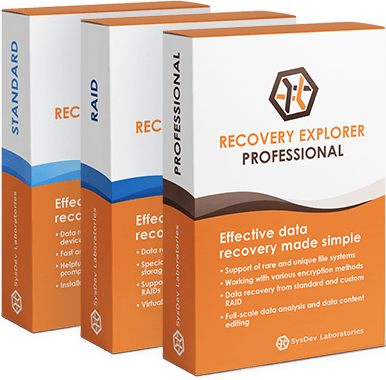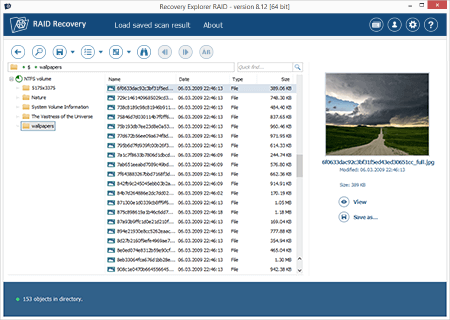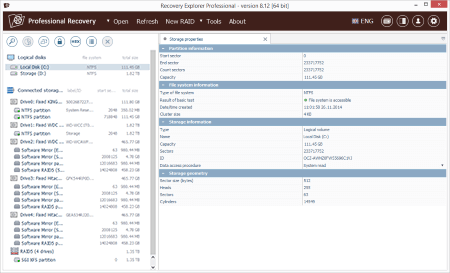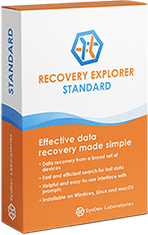
Recovery Explorer
is a universal software solution designed to bridge the gap between far-reaching data recovery possibilities provided by purely professional utilities and a straightforward data recovery procedure which can be easily accomplished by both beginners and experienced computer users.
Professional quality made easily achievable
The software offers an optimal mix of advanced technologies, rich functionality, high adjustability and an intuitive interface serving to make the extraction of lost information maximally productive and smooth.

The software provides convenient means for handling regular data recovery tasks, like restoring mistakenly deleted files, salvaging data after storage formatting or its damage caused by malware or other logical problems. The highly sophisticated scanning and reconstruction techniques employed by it are counterbalanced by a friendly interface, making the software readily usable even for persons with basic computer literacy. Moreover, numerous supplementary features, like on-the-spot preview of files, customizable search, disk imaging tool, etc. considerably facilitate the recovery process.

In addition to simple digital media, like internal and external hard disk drives, memory cards, USB sticks and their images, the software allows assembling and processing composite logical volumes, complex RAID configurations, decrypting encrypted devices or opening virtual disks of virtual machines, even when they are located on another virtual storage. Special tools provide the possibility to find lost partitions or define them manually within a certain region. Furthermore, a broad set of instruments for the analysis of raw binary data and its manual correction allows handling instances of serious logical damage.
The software gives direct access to the intact file system data and allows restoring the missing files from such types of file systems as FAT/FAT32, exFAT, NTFS and ReFS/ReFS3 of Windows, HFS+ and APFS of macOS, Ext2/Ext3/Ext4, XFS, JFS, ReiserFS, UFS, UFS2, Btrfs, ZFS, F2FS of Linux and VMFS/VMFS6 of VMware. Using this product, one can also work with such modern technologies as Apple Software RAID, Fusion Drive, FileVault2 and encrypted APFS, mdadm, LVM with Thin Provisioning and LUKS of Linux, Dynamic disks, Storage Spaces and BitLocker of Windows.
The software supports both automatic and manual assembly of RAID. Among the handled RAID types are simple configurations (RAID 0, RAID 1, RAID 3, RAID 5, RAID 6, etc.), nested layouts (RAID 10, RAID 50, RAID 60, etc.), non-standard setups (Synology Hybrid RAID, ZFS RAID-Z, Btrfs-RAID) and custom RAID patterns. The hexadecimal content of an array can be visualized for verification of its consistency or the correctness of the chosen level. It is also possible to present the scheme of RAID as a gird or build an entropy histogram of its data distribution.
Software editions for cases of different complexity
Recovery Explorer is represented by three separate editions. Each of them is characterized by its own functional capabilities so that everyone could choose an application relevant to their data recovery needs.

The program allows exploring the available content of intact partitions without a prior scan. If the volume was deleted or lost, the software offers several mechanisms for its reconstruction.
The utility supports a wide range of file systems applied in most common operating systems, including Windows, Linux and macOS.
The application provides an optional Wizard-based interface with embedded prompts, tips and explanations helpful for users without previous experience.
The software incorporates various auxiliary functions, like saving of scan results, files preview, basic and advanced file search, sorting and filtering options and many others.

The program is able to identify the initial parameters of RAID through its metadata and utilizes this information for instant reconstruction of the array.
The application handles complex storage systems of various types and levels, including standard setups, nested patterns and custom configurations.
The utility automatically assembles such storages as Windows Dynamic disks and Storage Spaces, Linux LVM, LVM 2 and mdadm, Apple Software RAID, etc.
Along with complex storage systems, the software allows recovering data from any stand-alone physical or virtual digital medium with equal efficiency.

In addition to common “user” file systems, the software supports ones applied on servers, like ReFS/ReFS3 of Windows, XFS, ReiserFS, Btrfs, ZFS of Linux and others.
The program allows working with disk volumes encrypted with the help of LUKS, BitLocker, File Vault 2, etc. without their prior decryption in the operating system.
The application supports such technologies as mdadm, Synology SHR, ZFS RAID-Z, Btrfs-RAID, Apple Core Storage, Linux LVM, Windows LDM, Storage Spaces and others.
The utility works with virtual disks employed by major virtualization software, like VMware, Microsoft Hyper-V, VirtualBox, QEMU and XEN.